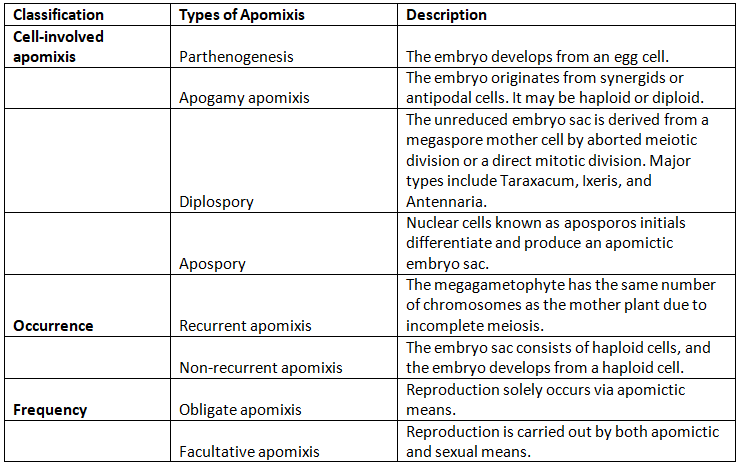Apomixes | Botany Optional for UPSC PDF Download
| Table of contents |

|
| Apomixis |

|
| Characteristics of Apomixis |

|
| Classification of Apomixis |

|
| Applications of Apomixis |

|
Apomixis
Apomixis, a term coined by the eminent botanist Hans Winkler, serves as an intriguing mechanism in the realm of plant reproduction. It represents a method of asexual reproduction whereby plant seeds develop without the customary process of fertilization. In essence, apomixis is the art of generating diploid embryos or seeds within a plant, all without the need for fertilization, effectively bypassing two fundamental aspects of sexual reproduction: meiosis and fertilization. This remarkable process results in the germination of seeds that produce plants precisely identical to the maternal clone.
Characteristics of Apomixis
- Asexual Reproduction: Apomixis serves as an asexual means of plant reproduction, notably prevalent in various species, particularly in fruit crops.
- No Genetic Recombination: This process omits the union of male and female gametes, leading to the absence of genetic recombination. Consequently, apomixis does not contribute to genetic diversity within a population.
- Absence of Gene Flow: Apomixis precludes gene flow, preventing the amalgamation of genes from diverse sources.
- Pure Line Development: It facilitates the rapid generation of pure lines and can be attained through haploid parthenogenesis.
- Genetic Control: Apomixis can be genetically regulated, proving invaluable for preserving superior genotypes and hybrid vigor.
- Widespread Occurrence: Remarkably, apomixis has been reported in over 300 plant species spanning 35 diverse families.
Classification of Apomixis
Apomixis can be classified based on several factors, including the cell involved, occurrence, and frequency.
The following table elucidates the different types of apomixis:
Examples of Apomixis
Apomixis can be observed in various plant species, including hawthorns, shadbush, Sorbus, brambles, blackberries, meadow grasses, mat grass, and hawkweeds.
Applications of Apomixis
Apomixis holds significant relevance in the realm of plant breeding and agriculture, providing several practical applications:
- Development of Pure Lines: Apomixis enables the rapid production of pure lines in plants, which can then be employed to develop high-yielding cultivars and hybrids after colchicine treatment.
- Maintenance of Purity: Obligate apomixis maintains the genetic characteristics of the mother plant, ensuring genetic purity across generations.
- Conservation of Heterosis: Recurrent apomixis is instrumental in preserving hybrid vigor over multiple generations, as it precludes segregation.
- Efficient Hybrid Seed Production: Apomixis simplifies the process of hybrid seed production, eliminating the need for traditional cross-breeding methods.
Advantages of Apomixis
The advantages of apomixis in plant breeding are noteworthy:
- Rapid Multiplication: Apomixis facilitates the swift multiplication of genetically uniform progenies without the risk of segregation.
- Permanent Hybrid Vigor: It enables the fixation of hybrid vigor in crop plants, ensuring long-term benefits.
- Stability of Maternal Characteristics: Apomictic progenies retain maternal characteristics across generations.
The Significance of Apomixis
In the realm of plant breeding and agriculture, apomixis plays a pivotal role. By allowing seed development without fertilization, it offers a cost-effective and efficient means of large-scale production, resulting in increased yields and the preservation of desirable crop traits. Moreover, it fosters genetic stability, contributing to the perpetuation of superior plant characteristics.
Conclusion
In conclusion, apomixis stands as a captivating phenomenon in the world of plant biology, offering numerous benefits in the realms of breeding and agriculture. Its ability to generate seeds without the need for fertilization has far-reaching implications, promising a future of increased crop yields and genetic stability in plant populations.
|
179 videos|140 docs
|

|
Explore Courses for UPSC exam
|

|











